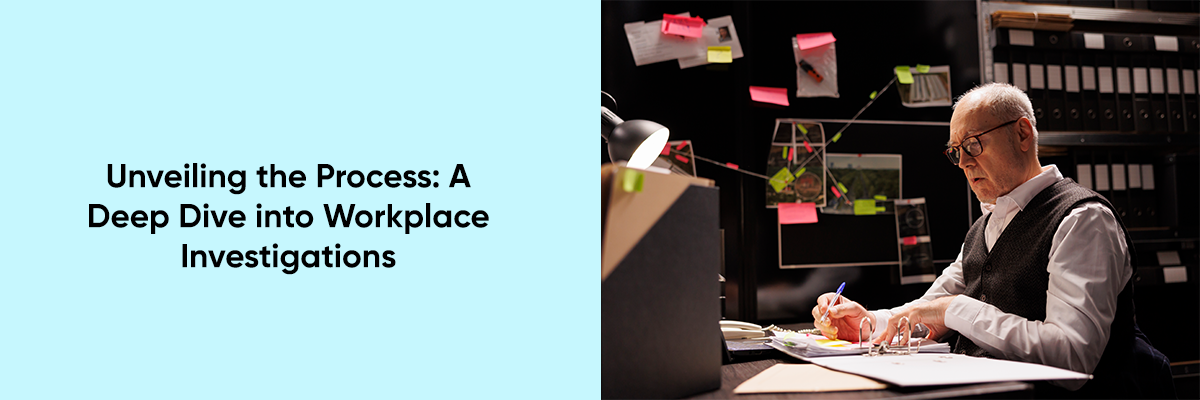Effectively resolving workplace issues in-house is crucial for maintaining a healthy work environment and preventing external interference. When internal investigations are not conducted properly, it increases the risk of government or other regulatory bodies stepping in to conduct their own investigations and address the issues. This not only brings unwanted scrutiny but can also damage the company’s reputation and lead to legal consequences.
In this blog, we will walk you through the entire process of workplace investigations, detailing each step, explaining how to conduct them, and outlining what to do once the investigation is concluded. We will also cover the dos and don’ts of workplace investigations to ensure they are conducted efficiently and fairly.



What is a Workplace Investigation?
A workplace investigation is a systematic process undertaken by an employer to address complaints, allegations, or concerns raised by employees. These investigations aim to uncover the truth, resolve disputes, and maintain a safe and productive work environment.
The Process of Workplace Investigations
Step 1: Initial Complaint and Response
- Receiving the Complaint: When an employee raises a complaint, it should be taken seriously and documented immediately. For instance, Susan, a new employee in a digital marketing company, accuses a member of top management of discrimination and threats.
- Acknowledging the Complaint: Respond promptly to the complaint. Let Susan know that her concerns are being taken seriously and that an investigation will be conducted.
Step 2: Planning the Investigation
- Assigning an Investigator: Choose an impartial investigator who has no direct involvement in the case. This could be an HR professional or an external consultant. In Susan’s case, the HR manager assigns an experienced external consultant to ensure impartiality.
- Defining the Scope: Determine what the investigation will cover, including specific allegations and relevant policies or laws. The scope will include Susan’s allegations of discrimination and threats, as well as any related company policies.
- Creating a Plan: Outline the steps of the investigation, including who will be interviewed and what evidence will be collected. The plan involves interviewing Susan, the accused, and any witnesses, as well as reviewing relevant documents and communications.
Step 3: Conducting Interviews
- Interviewing the Complainant: Start with Susan to understand her perspective and gather detailed information about her allegations. Susan provides specific instances and evidence of the alleged discrimination and threats.
- Interviewing the Accused: Speak with the accused person to get their side of the story. The accused manager provides their account of the events and any supporting evidence.
- Interviewing Witnesses: Identify and interview any witnesses who may have observed the incidents in question. Colleagues who worked closely with Susan and the manager are interviewed to gather additional insights.
- Documenting Interviews: Record all interviews accurately, ensuring that statements are clear and detailed. All testimonies are documented meticulously to ensure accuracy.
Step 4: Gathering Evidence
- Collecting Documents: Gather relevant documents, such as emails, messages, CCTV footage, call recordings or reports that may provide context or evidence. In Susan’s case, CCTV footage and the trail of emails between her and the manager are reviewed for any discriminatory or threatening content.
- Reviewing Policies: Examine company policies related to discrimination and threats to see if they have been violated. The company’s anti-discrimination policy is scrutinized for compliance.
- Analyzing Data: Look for patterns or inconsistencies in the information provided by different parties. All collected evidence is analyzed for consistency and relevance.
Step 5: Analyzing the Findings
- Evaluating Evidence: Assess all the evidence collected to determine its credibility and relevance. The investigation team evaluates the credibility of Susan’s allegations and the manager’s defense.
- Making a Determination: Decide whether the allegations are substantiated based on the evidence. Based on the evidence, a determination is made regarding the validity of the allegations.
Step 6: Taking Action
- Reporting Findings: Prepare a comprehensive report summarizing the investigation process, findings, and conclusions. A detailed report is created outlining the findings related to Susan’s complaint.
- Implementing Actions: If the allegations are substantiated, take appropriate disciplinary actions against the accused. If not, consider measures to resolve any underlying issues. Disciplinary action is taken against the manager if the allegations are found to be true, or alternative measures are suggested if the allegations are unsubstantiated.
- Communicating Results: Inform Susan and the accused of the investigation outcomes and any actions taken. Susan and the manager are informed of the investigation results and any subsequent actions.
Step 7: Follow-Up
- Monitoring the Workplace: Ensure that the work environment remains safe and supportive for all employees. The HR team monitors the workplace to ensure no further incidents occur.
- Providing Support: Offer support to those affected by the investigation, including counseling or additional training. Susan is offered counseling and additional training is provided to the management team.
Dos and Don’ts of Workplace Investigations
Dos:
- Do Act Promptly: Address complaints quickly to prevent escalation.
- Do Ensure Confidentiality: Maintain privacy to protect all parties involved.
- Do Be Impartial: Avoid bias and ensure a fair investigation.
- Do Document Everything: Keep detailed records of all steps and findings.
Don’ts:
- Don’t Ignore Complaints: Every complaint should be taken seriously.
- Don’t Delay: Timely investigations are crucial for credibility.
- Don’t Assume: Base conclusions on evidence, not assumptions.
- Don’t Retaliate: Ensure there is no retaliation against anyone involved in the investigation.
Conclusion
Conducting workplace investigations properly is vital for maintaining a harmonious and productive work environment. By following a structured process and adhering to best practices, companies can effectively address and resolve conflicts internally, minimizing the risk of external interference and legal repercussions. Ensuring clarity, communication, collaboration, compromise, and control throughout the investigation process fosters trust and promotes a positive workplace culture.


